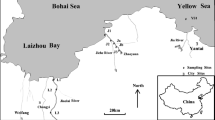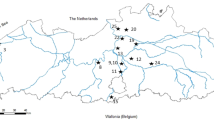Abstract
The release of NH +4 and15N-labelled NH +4 by one-step KCl extraction was assessed in different types of coastal marine sediments. KCl was efficient to extract NH +4 from sandy sediments and less efficient in silt sediments, where an extended extraction period was required for obtaining a maximum NH +4 yield. Extraction at 0 or 20 °C had only a little effect on the efficiency of KCl. KCl gave always non complete recovery of15NH +4 in silt sediments. However, the added label could be fully recovered by addition of 80 μmol·cm−3 exogenous NH +4 prior to KCl, or when NaCl or ASW replaced KCl.15NH +4 was added to non-biological silt sediment, which was incubated at 0 °C up to 16 hours, to see the effect of physical processes on the partition of15NH4 among porewater (29–49%) exchangeable (9–30%) and non-extractable, organic bound pools (24–42%). Total15N recovery was approximately 100%. KCl failed to remove15NH4 which entered to unknown, bound pools in sediment. Only shortly after addition of15N (0.1 h), the extraction period resulted in significantly different15N recoveries (P < 0.05) in KCl extractable NH +4 , 17% versus 9% of label was recovered after 1 min or 60 min extraction of sediment, respectively. Two hours of incubation time were required for complete equilibrium of15NH +4 among porewater, exchangeable and organic bound pools. Sediments (silt) to which15NH +4 has been added in order to measure NH +4 turn-over and KCl is used as extractant, should be incubated for at least 2 hours, before taking a zero-time sample.
Similar content being viewed by others
References
Amberger A (1989) Research on dicyandiamide as a nitrification inhibitor and future outlook. Communications in Soil and Plant Analysis 20: 1933–1955
Azam F, Mulvaney RL & Stevenson FJ (1989) Transformation of15N-labelled leguminous plant material in three contrasting soils. Biology and Fertility of Soils 8: 54–60
Bremner JM (1965) Inorganic forms of nitrogen. In: Black CA (Ed) Methods of Soil Analysis. Part 2. Agronomy 9 (pp 1179–1237). American Society of Agronomy, Madison
Brodrick S, Cullen P & Maher W (1987) Determination of exchangeable inorganic nitrogen species in wetland soils. Bulletin of Environmental Contamination Toxicology 38: 377–380
Fort RS, Sheppers J & Holzhey CS (1993) Comparison of potentially mineralizable nitrogen using electro-ultracentrifugation and some other procedures. Journal of Environmental Science & Health A28 6: 1171–1183
Guiraud G & Marol C (1992) Influence of temperature on mineralization kinetics with a nitrification inhibitor (mixture of dicyandiamide and ammonium thiosulphate). Biology and Fertility of Soils 13: 1–5
Haines E, Chalmers A, Hanson R & Sherr B (1977) Nitrogen pools and fluxes in a Georgia salt marsh. In: Wiley ML (Ed) Estuarine Processes. Vol 2 (pp 241–2542). Academic Press, New York
Jørgensen BB & Sørensen J (1985) Seasonal cycles of O2, NO +3 and SO 24 − reduction in estuarine sediments: the significance of an NO −3 reduction maximum in spring. Marine Ecology - Progress Series 24: 65–74
Laima MJC (1992) Evaluation of the indophenol method to measure NH +4 in extracts from coastal marine sediments. Marine Chemistry 39: 283–296
Laima MJC (1993) Recovery of15NH +4 in labelling experiments on coastal marine sediments. Marine Chemistry 44: 31–42
Mackin JE & Aller RC (1984) Ammonium adsorption in marine sediments. Limnology and Oceanography 29: 250–257
Mackown CT, Brooks PD & Smith MS (1987) Diffusion of nitrogen-15 in Kjeldahl digests for isotope analysis. Soil Science Society of American Journal 51: 87–80
McCarthy GW & Bremner JM (1989) Laboratory evaluation of dicyandimide as a soil nitrification inhibitor. Communications in Soil Science and Plant Analysis 20: 2049–2065
Muus BJ (1967) The infauna of Danish estuaries and lagoons. Medd. Danmarks Fiskeri og Havundersøgelse. NS 5: 1–36
Nõmmik H (1957) Fixation and defixation of ammonium in soils. Acta Agricultura Scandinavia 7: 395–436
Nõmmik H & Vahtras K (1982) Retention and fixation of ammonium and ammonia in soils. In: Stevenson FJ (Ed) Nitrogen in Agricultural Soils (pp 123–171). American Society of Agronomy, Madison
Sahrawat KL (1979) Evaluation of some chemical extractants for determination of exchangeable ammonium in tropical rice soils. Communications in Soil Science and Plant Analysis 10: 1005–1013
Simon NS & Kennedy MM (1987) The distribution of nitrogen species and adsorption of ammonium in sediments from The Tidal Potomac River and Estuary. Estuarine Coastal & Shelf Science 25: 11–26
Wang L & Øien A (1986) Determination of Kjeldahl nitrogen and exchangeable ammonium in soil by the indophenol method. Acta Agricultura Scandinavia 36: 60–70
Author information
Authors and Affiliations
Rights and permissions
About this article
Cite this article
Laima, M.C.J. Is KCl a reliable extractant of15NH +4 added to coastal marine sediments?. Biogeochemistry 27, 83–95 (1994). https://doi.org/10.1007/BF00002812
Received:
Accepted:
Issue Date:
DOI: https://doi.org/10.1007/BF00002812




